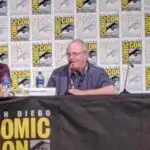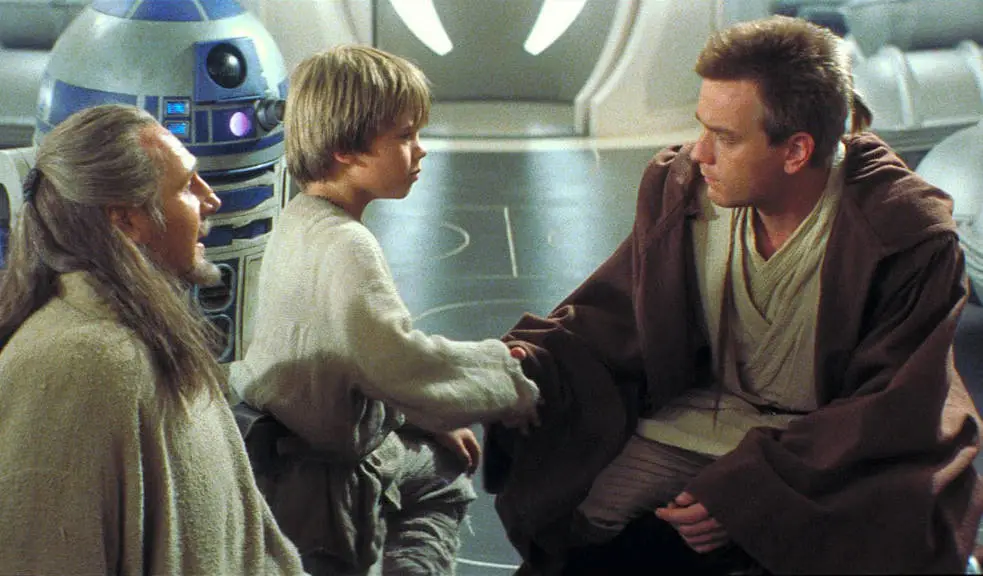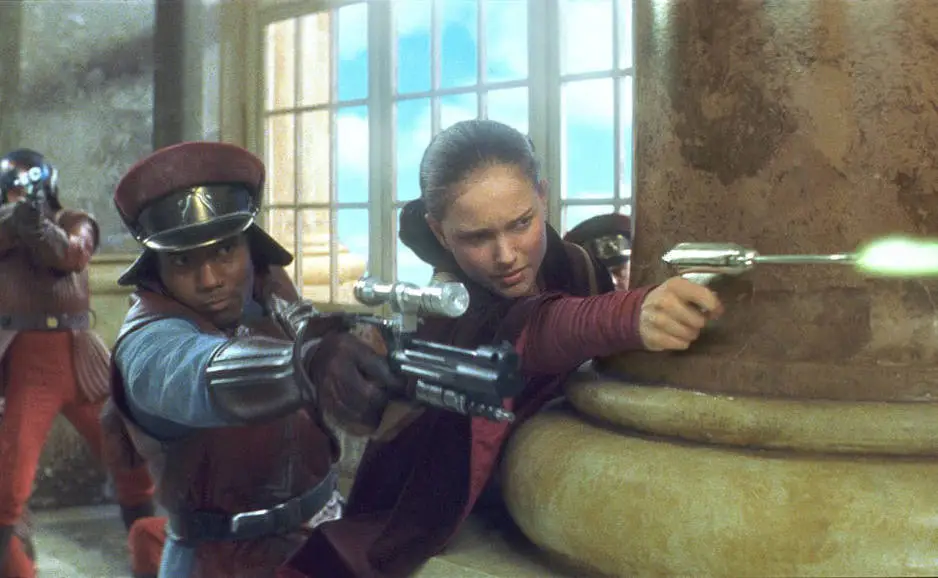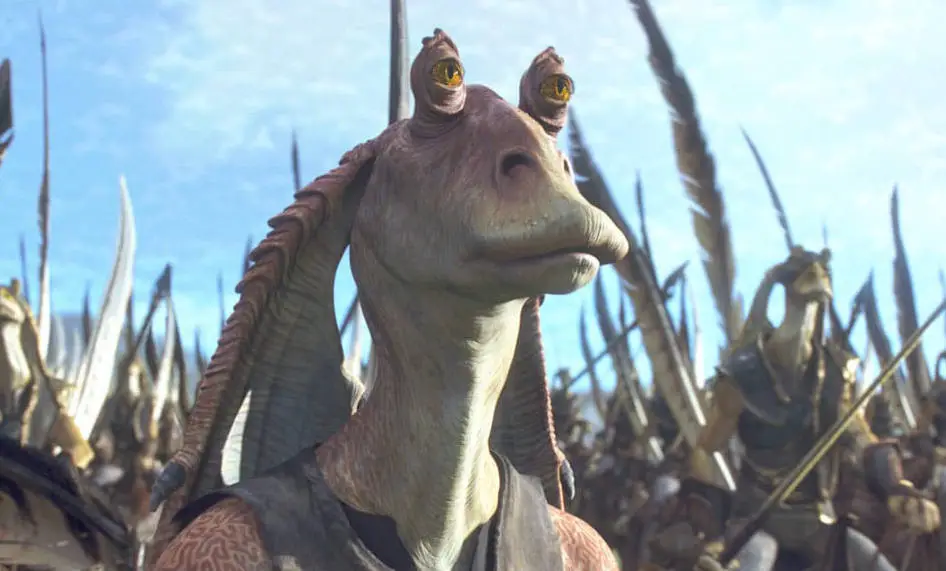In the run-up to the release of Star Wars: The Rise of Skywalker and the end of the Skywalker Saga, we will be taking a look back at all of the Saga films and re-evaluating them and their legacy as a whole.
Star Wars: Episode I The Phantom Menace
Here’s where things get weird. As much as has been written about the influences of and important participants in the original Star Wars films, even more has been penned about where Lucas’ prequels follow up. An entire industry has sprung up to analyze the missteps of the prequel trilogy and, in particular, its initial offering – Star Wars: Episode I The Phantom Menace (Unfortunately, this will not be the last time that can be said, either). And most of it is wrong.
That’s not to say audiences secretly loved The Phantom Menace or that it doesn’t have its issues. It is extremely uneven, with high highs and low lows. Though there is some intentional repetition in it, it dispenses with much of the audience and fan baiting of Return of the Jedi to focus on more new ideas and presentations of those ideas, expanded world-building, and subversion of expectations. Given the longest preparation time of any of the Star Wars films since the first one, it is probably the purest distillation of Lucas’ original vision of what Star Wars is.
That obviously didn’t work for a lot of people, and many, many, many reasons have been given and repeated ad nauseam about why that is: it uses too much computer-generated imagery ruining the aesthetic; its dialogue is terrible, and Lucas can’t get the actors to deliver it well; the actors spend all of their time in worlds of blue screen and no longer interact with their world-destroying suspension of disbelief; the plot focuses on trade and politics which is too boring to make a Star Wars film about; it is too childish and features a terribly misconceived character in Jar Jar Binks; Lucas surrounded himself with yes men who couldn’t bring themselves to tell him when he was going too far; and on and on and on.

The reality is people say a lot of things, but it’s what they do that matters, and when given the choice, many of the criticized elements of The Phantom Menace have been accepted elsewhere. The Phantom Menace was (for a while) one of the last of the series made with traditional elements — traditional film stock, a reliance on sets, locations, puppets, and model work along with CGI — and yet it is the most problematic of the prequels so those issues can’t have much bearing on whether a film works or not.
Other movies after the series have used more CGI (Avatar) or more overtly cartoonish characters (Transformers, Fast and the Furious) with similar issues of dialogue and performance and have been popular at least for a while. These elements, all pinged as the sword in the stone, the key to what went wrong, have been accepted in other milieus.
The real stumbling block for The Phantom Menace, and the boldest piece of experimentation in it, is its use of language.
Language is a great barrier to others. There is a lot we will put up with if we can understand the information coming towards us and recognize it as part of our tribe or shared cultural understanding. We are more likely to accept the stranger at the table if we can understand their explanations of who they are, where they come from, and that they mean no harm. One of the first core elements of creating a nation-state is a required language that every citizen speaks.
It extends to film and other cultural products as well. Plenty of modern film spectaculars have frankly terrible dialogue which encumber at best middling performances — the Fast and the Furious films spring immediately to mind — but are accepted nonetheless because they sound like people of today, they sound like us.
Sure, it’s bad, but it’s relatable, and that’s what matters. Similarly, period pieces made in the present day are mostly given a modern sound in order to keep the events relevant to the current audience, while anything in a foreign language or with an out-of-the-ordinary cadence or word use (Robert Eggers’ The Lighthouse, for instance) is immediately in the realm of the specialized and left only for small films or smaller audiences. Even the works of Shakespeare become niche within the global mainstream culture.
The Phantom Menace doesn’t care about any of that. From the outset, it makes the declaration that ‘this is another time, another place,’ giving every line a formal mien. It delivers information directly, without subterfuge or poetry. It’s so stylized that the actors in the movie might as well be speaking a foreign language as far as a modern audience is concerned. The formal diction necessarily leads to formal delivery and stiff performances. This is not a bug but an intentional design; the actors sound like what they are supposed to sound like, and it is not supposed to sound normal.
It compares to the similarly intentional stylization of Kenji Mizoguchi’s Ugetsu and especially Sergei Eisenstein’s Ivan the Terrible, where the actors are so intentionally performing in an abstract way it cannot possibly be confused as human, but instead entirely reflective of the world of the film (and is completely understandable that way).
It’s the way people act there because it’s the way people act there. It is also an artistic choice which, as a culture, we will accept within niche products but, when applied to something that ostensibly is a mass culture, mass audience event, is rejected. Big budget adventure films just aren’t supposed to sound this way.
And yet, within it, the choice produces some of the best performances of the film, if not the series. Much as with the original trilogy, the experienced theatrical actors (Liam Neeson, Ian McDiarmid) are best able to pull an audience into their strange words and make them relatable. Neeson grounds the film in warm humanism, and Ewan McGregor produces a young Obi-Wan Kenobi, who manages the difficult task of matching Alec Guinness’ performance without mimicking it.
However, in The Phantom Menace, it is Natalie Portman who produces the best performance when, in her Queen persona, she has to convey complex emotions without the luxury of being able to speak them. The old adage is ‘acting is reacting’, and it’s no accident that in any given scene with Portman in it, the reaction closeup is usually on her as she evinces exactly what she’s feeling with the subtlest of facial expressions. The sequence where she must call for the expulsion of her political ally despite clearly not wanting to is a highlight. Again, not by accident; the entire conclusion of the scene is explained by the silent acting of Portman and McDiarmid.
This will become a hallmark of Lucas’s later work and one of his biggest breaks with norms. When characters need to convey information they speak, when they need to convey emotion they mostly don’t.
As with Return of the Jedi, it’s a rule Lucas sticks to except when he doesn’t, and that’s when problems show up. Outside of the formal elites of his world — the Jedi, the Senators, the Queens — he returns actors to more modern-ish dialogue and delivery, particularly Jake Lloyd and Handmaiden Portman, and the effect is jarring. They sound like outsiders in the world they are in the middle of and to the world of the audience making empathy and meaning from the words difficult for everyone, actors included. It’s an issue pushed even further for Jar Jar Binks, a character intentionally breaking the mold for what Star Wars could look, sound, or act like.
He’s a completely CGI character, he’s comedic, he doesn’t sound remotely like anything else speaking a language anywhere. It’s a lot of experimentation in one package, maybe too much, although the character’s only real failing is his inability to evolve. He starts oblivious to the problems around him, acting through cowardice and succeeding by luck, and he ends up pretty much the same way. Even during the final battle, when he is named a general, he’s not given a chance to choose to be one.
[This is not the film’s greatest narrative weakness, as he and Anakin are ultimately supporting characters. The one true storytelling problem is the extended series of meetings the middle devolves into before Amidala decides to return to Naboo, ruining pace and momentum. But, much as with the start, once the ending is decided on, everything just flows].
He’s also a hallmark of just how technically proficient the film is. Mixing old and new technologies on a scale most films couldn’t match, it is probably still the best-looking of the prequels and one of the best-looking of the series. Lucas’ love of art direction is given free rein, resulting in worlds that look nothing like any we’ve seen before, even the ones we’ve seen before. Trisah Biggar’s costume design for the Queen eradicates simplicity and embraces complexity in truly breathtaking fashion.
It seems likely no character in the series, however long it lasts, will ever have a look again as wild as the Queen, but it’s right at home within the interstellar Renaissance world Naboo production designer Gavin Boquet created. The color choice, composition, and camera movement from start to end are top notch, even if they don’t push boundaries quite to the extent the other craft areas do.
Mostly, though, The Phantom Menace is just a giant hodge-podge of experimentation, aesthetically and technically, and it’s all directly in the audience’s face with very little familiarity left to hold on to. Barring an extended excursion to Tatooine, everything looks new and different from the previous films. The world of Star Wars is immeasurably expanded, increasingly beyond the bounds of what can be found naturally on our planet and into a world of pure imagination, as is the growing mythology.
Rather than repeat an archetypal good guy/bad guy narrative, Lucas envisions a real world and the things that a real world has run it – politics, taxes, trade. It is the ‘used universe’ aesthetic of the original films expanded to conceptual levels.
[It reminds me of the Wachowskis’ similar experiments with Speed Racer, which met with similar responses.]
At the same time, previous backstory elements — the Jedi Knights, the Old Republic — are given serious rethinks with an eye towards making them question our assumptions as to how great the old times were and whether the good guys were really good. Even young Obi-Wan Kenobi is revealed to have been impulsive and prone to surface-level judgments, a man who would have to grow and change to become his future self. It marks the moment the series moves beyond being about good versus evil and becomes about good and evil and how those ideas interact with the human experience.
The Phantom Menace, instead, is a bold announcement that the new films will do their best to try something new every time. They won’t always succeed, but even in failure, there is glory.
Rating: 6 out of 10 (Buy The Phantom Menace at Amazon)
NEXT: STAR WARS: EPISODE II ATTACK OF THE CLONES

Joshua Starnes has been writing about film and the entertainment industry since 2004 and served as the President of the Houston Film Critics Society from 2012 to 2019. In 2015, he became a co-owner/publisher of Red 5 Comics and, in 2018, wrote the series “Kulipari: Dreamwalker” for Netflix. In between, he continues his lifelong quest to find THE perfect tomato soup and grilled cheese sandwich combination.


